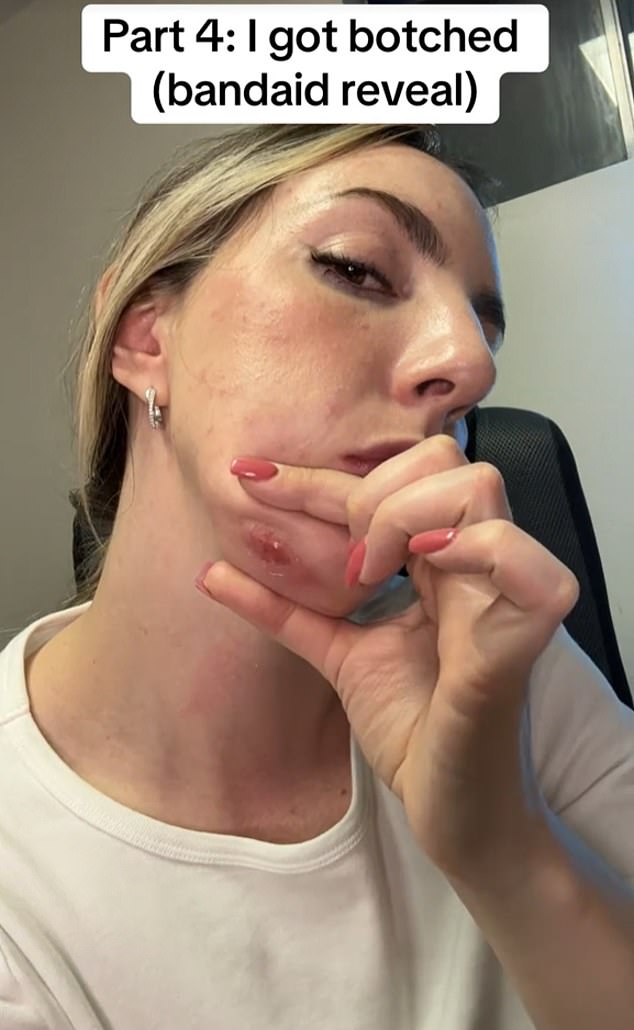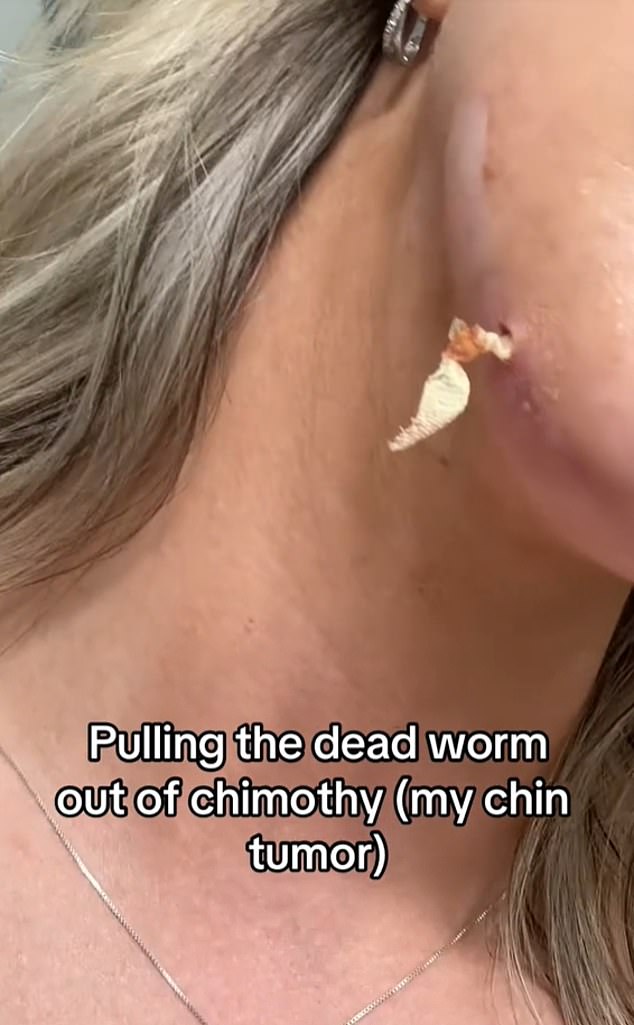My facial fillers gave me an oozing pus-filled ‘tumor’ on my chin…and I had to pull ‘worms’ out of it
A Colorado woman has issued a stark warning to those considering facial filler – after a botched procedure left her developing a huge growth on her chin that resembled a tumor.
Kaley Birge, a registered dietitian, had to undergo a painful procedure to drain infected fluid from the mass, which continued to ooze pus for more than two weeks.
Doctors identified the ‘tumor’ – which she calls ‘Chimothy’ – as an abscess, which had developed as a result of an infection at one of the injection sites.
Speaking about the ordeal in a series of TikTok videos, Ms Birge said: ‘I’m going to cry, I’m so disgusted. I find it difficult to talk about this because I find it so disgusting and I feel like I’m going to throw up.’
In one clip, she can be seen trying to empty the contents of the mass by squeezing it, causing blood and pus to ooze out.
TikToker Kaleysfavs said her filler got infected because she suffered from acne when she had the cosmetic procedure

Ms Birge said she covered the infected area with make-up to avoid embarrassment when she went to work
Ms Birge, who posts videos under the username Kaleysfavs, visited a clinic earlier this month for fillers in her chin area.
The shots contain gel-like substances such as hylauronic acid that fill areas of lost volume on the face and smooth wrinkles.
Around the time of the procedure, Ms. Birge said she was in “tremendous pain.” [acne] outbreak’ in the area where the filler was injected, increasing the risk of infection.
The infection developed less than a week after the procedure, Ms. Birge said.
The clinic that injected her filler told her to come back immediately because “they were concerned” and they prescribed her antibiotics.
However, her situation worsened and just a day later Mrs Birge returned and caregivers removed ‘a load of puss’ from the abscess.
When an infection develops, the immune system tries to fight it and white blood cells travel to the infected area and accumulate, forming an abscess.
The creator diligently took her antibiotics and painkillers, but pus and colorless fluid continued to ooze from the open wound.
Two days later, Ms. Birge returned to the facility again and her medical team performed an ultrasound of the area, which they said showed the swelling was “a huge bag of pus… they cut me open, drained the pus and then irrigated it. ‘
Mrs. Birge left the office with the abscess wrapped. Abscess packing occurs when the abscess cavity is filled with gauze or cotton after it has been cut and drained.
The purpose of wrapping is to prevent the abscess from closing so that it can continue to drain, absorb fluid from the abscess, and help prevent the growth of bacteria and infection.
When an abscess is packed, a small end of the pack is left visible from the incision so that the patient can pull out the gauze or cotton wool for several days after drainage.

The registered dietitian developed an abscess that she had to drain and pack several times

Mrs Birge had to remove the package, which she called a ‘dead worm’, from her abscess
Mrs Birge said: ‘I have to… [packing] just a little bit… I’m going to cry. I’m so disgusted by it. I find it difficult to talk about this because I find it so disgusting and I feel like I’m going to throw up.’
In a video a few days later, she showed herself pulling the package, which she called a “dead worm,” from her “chin tumor.”
Mrs. Birge was left with a small round gap on her chin, but a day later she noticed that her chin was still crooked and said, “There’s something underneath.”
In her next video posted last week, she said, “Something big and disgusting came out of Chimothy last night and [I don’t know] what must we do.’
In a graphic video, Ms Birge showed blood, pus and fluid coming out of the abscess opening as she rubbed around the area.
Two days after that, Mrs. Birge noticed a bump on the other side of her face, which she called “Chimothy’s little sister… Chimanthia.”
Another two days later, while attempting to drain the abscess again, the maker revealed that the filler she had injected had come out through the incision.
Ms. Birge did not specify which type of doctor administered her facial fillers, but there are many types of providers who are allowed to inject patients, depending on state laws.
However, she did say she was subsequently treated by a doctor, a physician assistant and a nurse and did not blame the clinic for her complications.
Dermal fillers are temporary and intended to last six to eighteen months – depending on the type of injection and the area where they are injected – as the body breaks down and absorbs the material.
Fillers, which are regulated by the FDA as medical devices, can be used on many parts of the body, including the chin, cheeks, lips, brow lines, jawline and forehead.
According to the American Society of Plastic Surgeons, more than 2.6 million Americans receive injectable facial fillers every year, making it the second most popular minimally invasive cosmetic procedure after Botox injections.
They average between $740 and $1,100, depending on location and type.
Common side effects of fillers include bruising, redness, pain, itching, rash and swelling at the injection site.
Rare side effects include loss of function of the injected area, migration of fillers throughout the face or body, chronic inflammation, infections, open or draining wounds and necrosis, or tissue death.
People may also experience allergic reactions and granulomas, small clusters of white blood cells and other tissues that resemble abscesses.
Although the cosmetic procedure is considered safe, An study found it 160 of the 430 complications reported in patients with fillers between 2003 and 2020 were classified as serious or permanent, including necrosis and vision loss.
The study authors warned that non-permanent fillers may be associated with “rare but potentially serious complications” depending on where they are injected. Its administration “requires in-depth knowledge of facial anatomy.”
